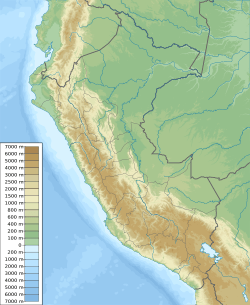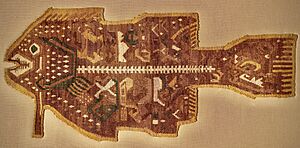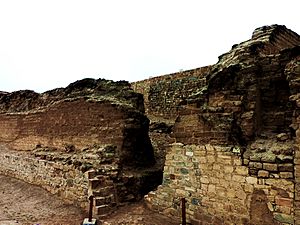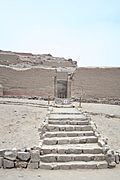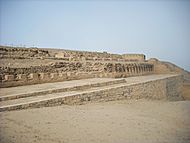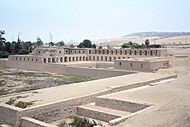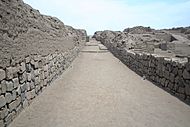Pachacamac facts for kids

View of Pachacámac
|
|
| Location | Lima |
|---|---|
| Coordinates | 12°15′24″S 76°54′01″W / 12.25667°S 76.90028°W |
| History | |
| Periods | Middle Horizon, Late Intermediate, Late Horizon |
| Cultures | Huari, Lima, Inca Empire |
| Site notes | |
| Website | Santuario Arqueológico Pachacámac (in Spanish) |
Pachacámac (Quechua: Pachakamaq) is an ancient site in Peru. It is about 40 kilometers (25 miles) southeast of Lima. The site is in the Valley of the Lurín River.
People first settled here around 200 AD. The site was named after the "Earth Maker" god, Pacha Kamaq. Pachacámac grew and thrived for about 1,300 years. This was until the Spanish arrived. The site covers about 600 hectares (1,480 acres) of land.
Contents
Pacha Kamaq, the Earth Maker God
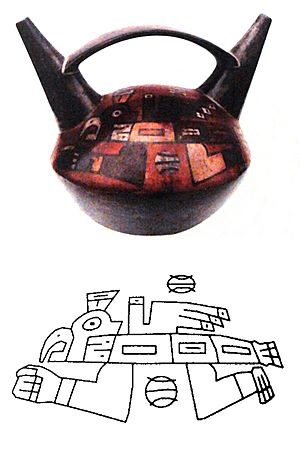
Pacha Kamaq means 'Earth-Maker'. People living in this part of Peru believed he was the creator god. This was before the Inca took over. The Inca people later included him in their group of gods. However, they saw their own god, Viracocha, as more powerful.
Stories about Pacha Kamaq are a bit confusing. Some say he was the brother of Manco Cápac. Others say he, Manco Cápac, and Viracocha were the only three sons of Inti, the sun god.
One story says Pacha Kamaq made the first man and woman. But he forgot to give them food. The man died, and the woman prayed to Inti, Pacha Kamaq's father. She asked to become the mother of all people on Earth. Pacha Kamaq became very angry. He tried to kill each child as they were born. But her hero-son, Wichama, defeated him. Wichama threw Pacha Kamaq into the sea. After this, Pacha Kamaq became the main god of fish.
Pyramids of Pachacámac
Archaeologists started exploring Pachacámac in the 1890s. They found many huge buildings and burial sites. Sadly, many of these had been robbed before.
The site has two main parts. The first part is sacred. It includes important religious temples and a large cemetery. The second part has several buildings. These are mostly pyramids used for everyday life, not just religion. These buildings are mud-brick pyramids with ramps and open areas. They were built between the late 1300s and mid-1400s.
The three most famous pyramids are in the sacred area. These are the Painted Temple, the Temple of the Sun, and the Old Temple of Pachacámac.
For many years, experts thought the pyramids in the second section were religious "embassies." They believed people from far away came to worship there. They would bring gifts and offerings to Pacha Kamaq. However, archaeologist Peter Eekhout studied the site. He found that these buildings did not look like religious centers of that time. He believes they were actually palaces. These palaces were for the Ychsma (EESH-ma) rulers of Pachacámac.
The Pachacámac Idol
In 1938, an archaeologist found a large wooden idol. It was 2.34 meters (7.6 feet) long and 13 centimeters (5.1 inches) wide. It was found at the Painted Temple. People believed this idol was destroyed by Hernando Pizarro.
Scientists used Carbon-14 dating on the idol. They found it was made around 760 to 876 AD. This was during the time of the Wari Empire. The idol was once painted with a red color called cinnabar.
Temple of the Sun
The Temple of the Sun is very large, about 30,000 square meters. It is shaped like a trapezoid. It has steps and terraces around it, like many ancient pyramids. This temple was built when the Inca controlled Pachacámac.
Some archaeologists think human sacrifices might have happened here. Remains of women and children were found in an Inca cemetery within the temple area. Items found with them suggest they came from coastal communities. We don't know everything about this site. The Temple of the Sun and other pyramids have been damaged. This damage is from looting and the El Niño weather events.
Old Temple
The Old Temple is also called the Temple of Pachacámac. It is the oldest building at the site. It was built on a rocky hill. It uses many small bricks made of raw adobe. This temple dates back to the Early Intermediate period. This was when the Lima culture was important (3rd to 7th centuries AD).
Other Structures
Most of the common buildings and temples were built between 800 and 1450 AD. This was just before the Inca Empire arrived and took over.
Grave Sites
Archaeologists have found many grave sites at Pachacámac. These sites are from different times in the city's history. They are in various parts of the city.
In the southeastern area, near the Temple of Inti (the Inca Sun God), a cemetery was found. This cemetery was for the mamacuna. These were women who had important roles. They wove cloth for priests and made corn beer for Inca festivals. Stone tombs here contained gifts from the highlands of Peru. These included coca, quinoa, and cayenne peppers.
In 2012, archaeologists from Belgium found a 1,000-year-old tomb. It was in front of Pachacámac. It held over 80 skeletons and mummies. Many of these were babies. The tomb also had ceramic pots, copper and gold objects, wooden masks, and remains of dogs and guinea pigs.
In 2019, another 1,000-year-old cemetery was found. Professor Peter Eeckhout, who leads the Ychsma Project, reported this. He said many human remains were buried with various items and pottery. Dr. Lawrence Owens studied the mummies. He noted that most people at the site had difficult lives. They had fractures, bad backs, and bad hips. The people in this cemetery had more signs of tuberculosis. They also had very serious bone breaks. But most of these injuries had healed. This suggests they were cared for. Even in early times, people felt a duty to help those who were less fortunate.
Outside Influences on Pachacámac
The Huari people (around 600–800 AD) rebuilt the city. They likely used it as a center for their government. Many Huari designs can be seen on the buildings. They are also on pottery and cloth found in cemeteries from that time. After the Huari empire ended, Pachacámac continued to grow as a religious center. Most of the common buildings and temples were built during this later period (around 800–1450 AD).
The Inca Empire took over Pachacámac around 1470. For the Inca, Pachacámac was very important for religion. It was also a key administrative center. The Inca had their own creator god, Viracocha. But they respected the local religion. So, they included Pacha Kamaq in their beliefs. However, Viracocha was still seen as more powerful. Even so, Pachacámac was allowed to be quite independent from the Inca Empire.
When the Tawantinsuyu (Inca Empire) arrived, the valleys of the Rímac and Lurín had a small state. Its people were called Ichma. They used Pachacámac mainly as a religious place. They honored Pacha Kamaq, their creator god. The Ichma people and Pachacámac joined the Inca Empire. The Inca kept the site as a religious shrine. They let the Pachacámac priests continue their work. This included the oracle, whom the Inca likely asked for advice. The Inca also built five more buildings. One was a temple to the sun in the main square.
Archaeologists believe people visited Pachacámac as pilgrims for thousands of years. This was even before the Inca made it part of their empire.
Spanish Invasion
When the Spanish arrived, they used local unhappiness with the Inca. This helped them overthrow Inca rule.
After the Battle of Cajamarca, Francisco Pizarro sent his brother, Hernando Pizarro. Hernando went to Pachacámac with fourteen horsemen. His goal was to collect its gold treasures.
According to a writer named Cieza, the priests heard that the Spanish had disrespected the temple in Cuzco. So, they told the mamaconas (important women) to leave the Temple of the Sun. The priests reportedly moved over four hundred loads of gold from there. They also moved gold from the Temple of Pachacámac. They hid the gold, and it has never been found. It is unlikely to be found by chance. This is because everyone who knew where it was hidden has died. Hernando left Cajamarca on January 5, 1533. He returned on April 14, 1533, after damaging the temple. On his way back, in the Jauja Valley, he accepted the surrender of Chalcuchimac.
Within a few years, Spanish settlers tore down the temple walls. They used the stones to build their own houses.
See also
 In Spanish: Pachacámac (sitio arqueológico) para niños
In Spanish: Pachacámac (sitio arqueológico) para niños
- List of buildings in Lima


